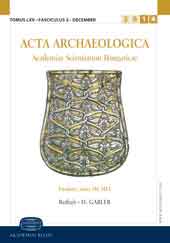Late Roman Period casket mount from Balatonlelle
Late Roman Period casket mount from Balatonlelle
Author(s): Gábor SerlegiSubject(s): Archaeology, Cultural history, Regional Geography, Ancient World, Cultural Essay
Published by: Akadémiai Kiadó
Keywords: Late Roman Period; Balatonlelle; 3-4th century AD; Celtic finds; Roman settlement structure;
Summary/Abstract: Excavations at the site of Balatonlelle-Kenderföld were conducted within the framework of the cooperation between the Directorate of the Museums of Somogy County and the Archaeological Institute of the Hungarian Academy of Sciences as part of the investment-driven excavations along the track of highway M7 in 2002. A short stretch of the track of the highway and the site of a future lay-by composed the excavation surface, which covered about four hectares (Fig. 1). The territory proved to have been inhabited in the prehistoric times (Late Neolithic, Early and Late Bronze Ages) and from the time that preceded the Roman occupation to the end of the Roman Period. The Late Iron Age and Roman Period pits uncovered outlined a uniform settlement structure. The finds recovered from the features imply that the rural settlement, whose traces were found, was inhabited for hundreds of years. In addition to the features that contained characteristic Celtic finds, there were many pits where the Roman material was mixed with Celtic finds, while the majority of the pits uncovered in the settlement contained only characteristic Roman vessel types. The find material delineates an undisturbed transition from the Late Iron Age to the middle of the 3rd century AD, since no break could be observed in the life of the settlement in this period and there was no trace of a sudden destruction or a systematic abandonment either.
Journal: Acta Archaeologica Academiae Scientiarum Hungaricae
- Issue Year: 56/2005
- Issue No: 4
- Page Range: 487-496
- Page Count: 11
- Language: English
- Content File-PDF

